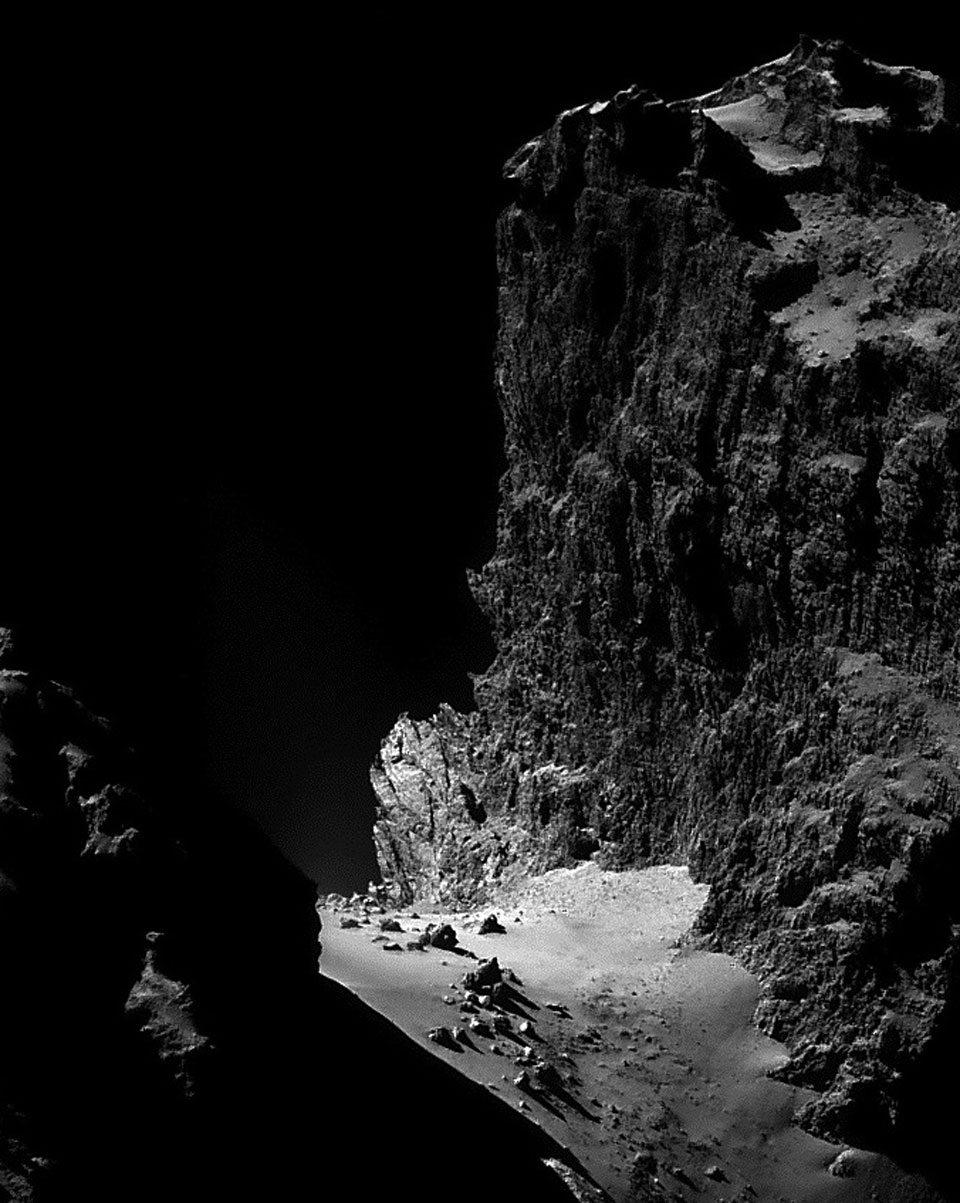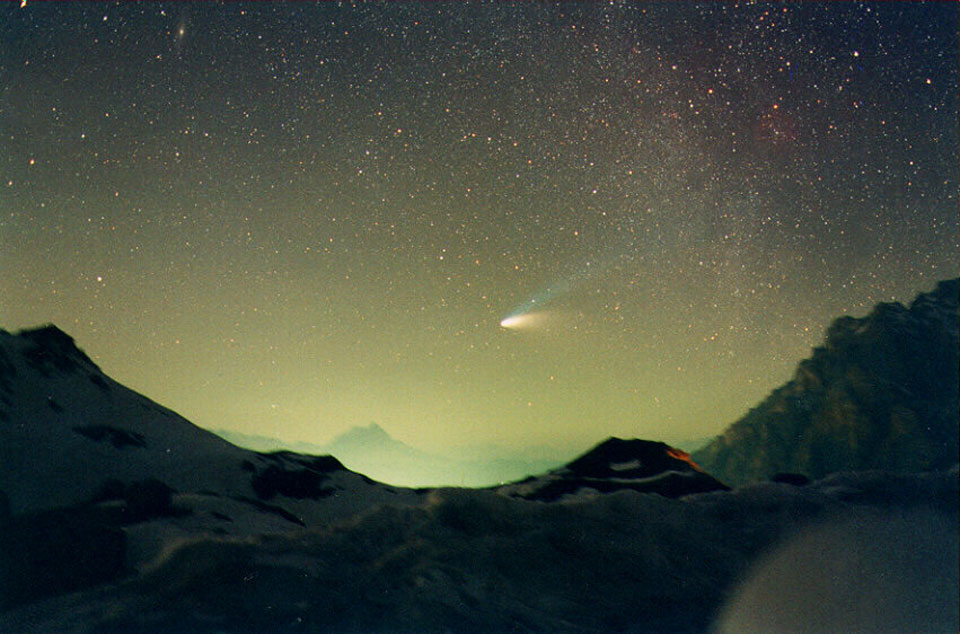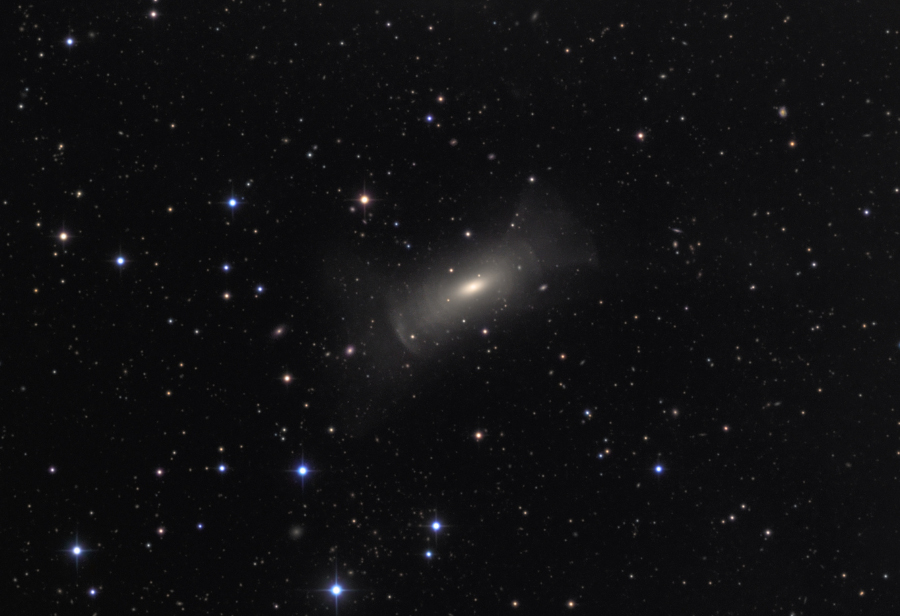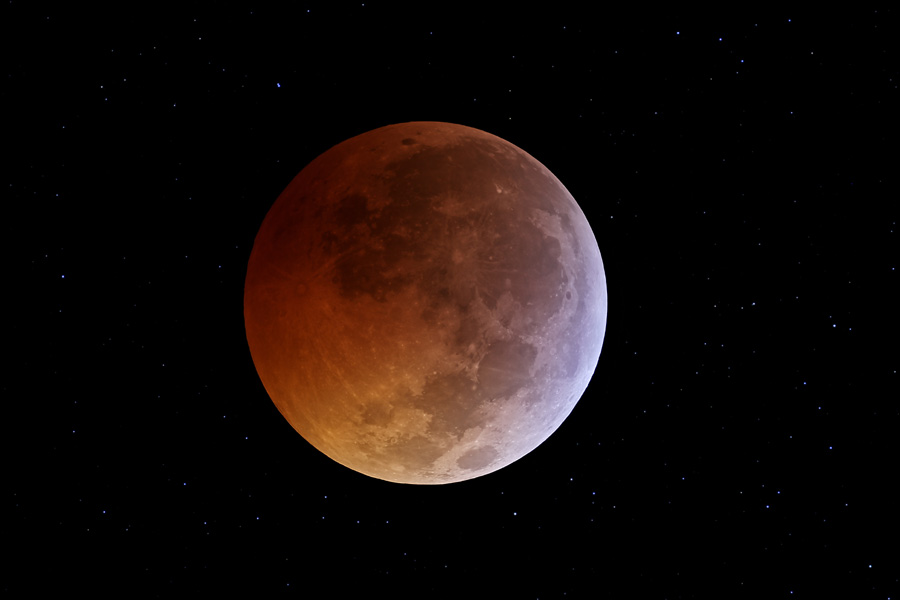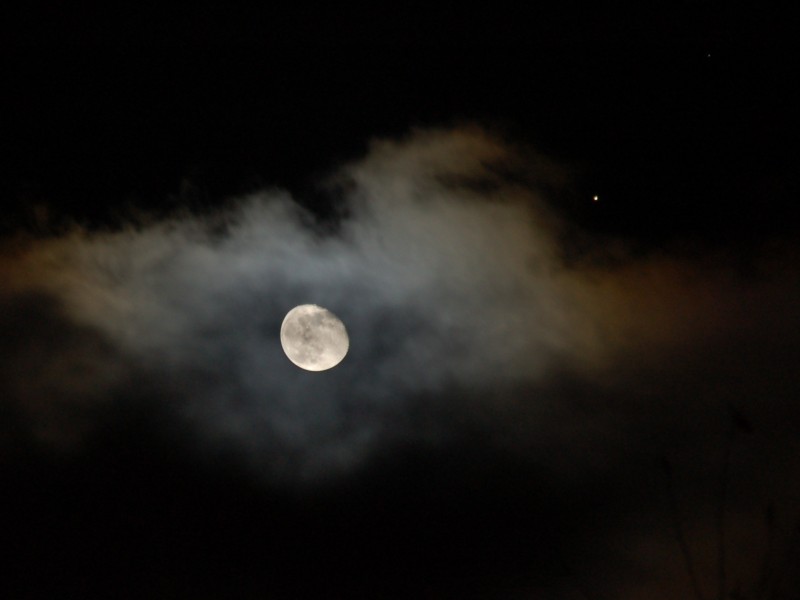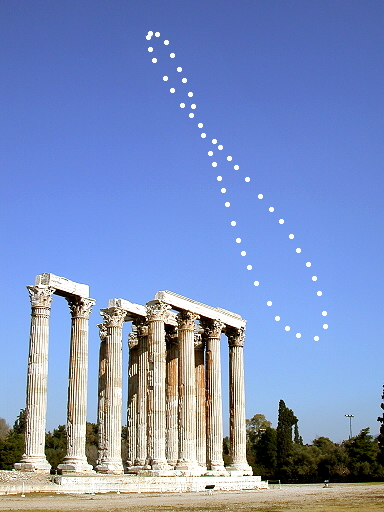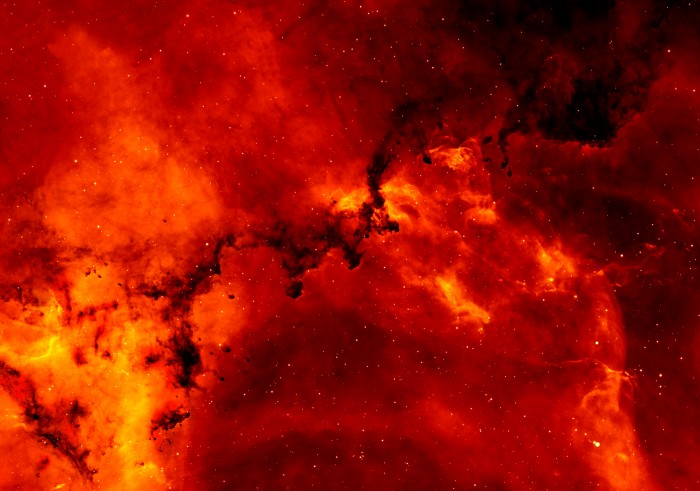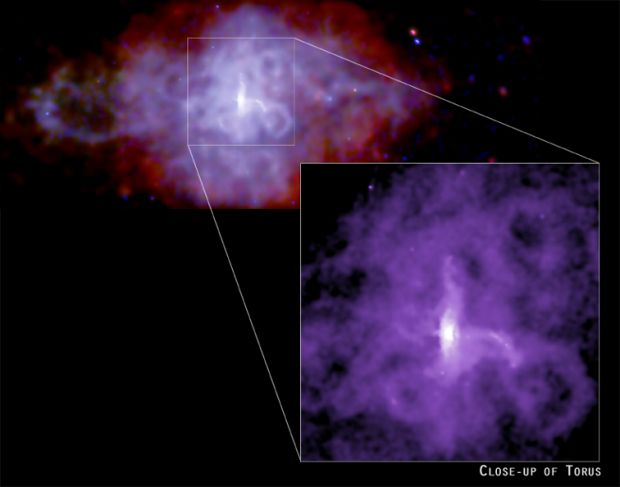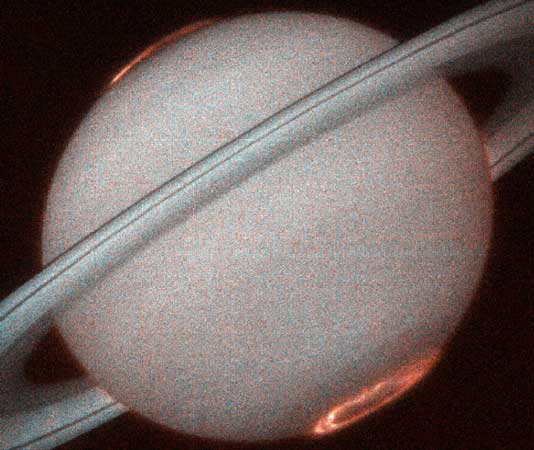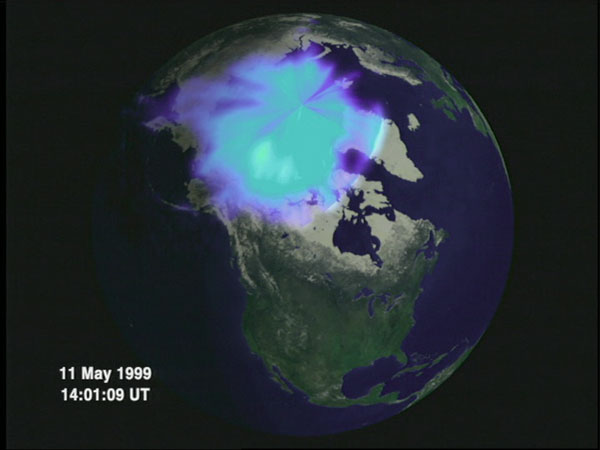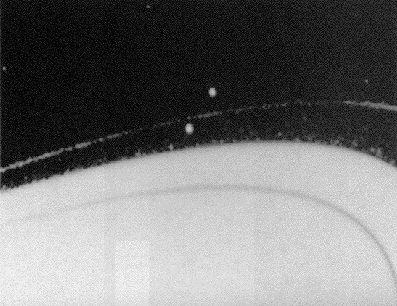| << Previous | Index | Next >> |
2014
2013
[imghover6=http://apod.nasa.gov/apod/image/1312/ge ... ky_960.jpg]http://apod.nasa.gov/apod/image/1312/ge ... labels.jpg[/imghover6]Image Credit & Copyright: Yuri Beletsky (Las Campanas Observatory, Carnegie Institution)
2012 Comet Hale-Bopp, the Great Comet of 1997, became much brighter than any surrounding stars. It was seen even over bright city lights. Away from city lights, however, it put on quite a spectacular show. Here Comet Hale-Bopp was photographed above Val Parola Pass in the Dolomite mountains surrounding Cortina d'Ampezzo, Italy. Comet Hale-Bopp's blue ion tail, consisting of ions from the comet's nucleus, is pushed out by the solar wind. The white dust tail is composed of larger particles of dust from the nucleus driven by the pressure of sunlight, that orbit behind the comet. Observations showed that Comet Hale-Bopp's nucleus spins about once every 12 hours. A comet that may well exceed Hale-Bopp's peak brightness is expected to fall into the inner Solar System next year.
2011
2010 A big, bright, beautiful Full Moon slid into planet Earth's shadow early Tuesday morning. Remarkably, the total lunar eclipse coincided with the date of the December Solstice. During the eclipse, the best viewing in North America found the coppery lunar disc high in a cold winter sky, the Moon reddened by light filtering into the Earth's dark central shadow or umbra. The light comes from all the sunsets and sunrises, seen from a lunar aperspective around the edges of a silhouetted Earth. Passing closer to the center of the umbra, the Moon's southern hemisphere (left) appears darker in this eclipse image, recorded from Deerlick Astronomy Village, Georgia, USA. The picture is a digital composite, a separate longer exposure added to an eclipse frame to capture the surrounding star field.
2009 The Sun is a moving target. Its annual motion through planet Earth's sky tracks north and south, from solstice to solstice, as the seasons change. On December 21st, the solstice marking the first day of winter in the northern hemisphere and summer in the south, the Sun rose at its southernmost point along the eastern horizon. Earlier this month, looking toward the Aegean Sea from a well-chosen vantage point at Cape Sounion, Greece, it also rose in this dramatic scene. In the foreground lies the twenty-four hundred year old Temple of Poseidon.
2008 Is this coat hanger a star cluster or an asterism? This cosmic hang-up has been debated over much of last century, as astronomers wondered whether this binocular-visible object is really a physically associated open cluster or a chance projection. Chance star projections are known as asterisms, an example of which is the popular Big Dipper. Recent precise measurements from different vantage points in the Earth's orbit around the Sun have uncovered discrepant angular shifts indicating that the Coat Hanger is better described as an asterism. Known more formally as Collinder 399, this bright stellar grouping is wider than the full moon and lies in the constellation of the Fox (Vulpecula). On the far right of the image is the open cluster of stars NGC 6802.
2007 The Full Moon and a brilliant, ruddy Mars will share the sky tonight. Skygazers can easily enjoy the celestial pairing as the two are separated by a degree or even less. In fact, seen from parts of northern North America and Europe, the Moon will actually occult (pass in front of) the Red Planet. Mars is so bright because it is near opposition, opposite the Sun in Earth's sky and near its closest approach to planet Earth. But Mars is not nearly as bright as the Moon, also opposite the Sun tonight. In this striking preview of tonight's sky show, backyard astronomer John Harms was able to photograph an almost Full Moon near Mars last month. His simple, single exposure relied on clouds to block some of the overwhelming moonlight.
2006 An analemma is that figure-8 curve you get when you mark the position of the Sun at the same time each day throughout planet Earth's year. Above, 47 separate exposures (plus one foreground exposure) were recorded on a single piece of film to illustrate this annual cycle of solar motion from March 30, 2003 to March 30, 2004. In the remarkable foreground are standing Corinthian columns of the ancient Temple of Olympian Zeus in Athens, Greece. Solstices, like the one that occurred at 0022 UT on December 22, correspond to the bottom of the figure-8 or the southernmost excursion of the Sun in the sky. The tilt of planet Earth's axis and the variation in speed as it moves around its orbit combine to produce the graceful analemma curve.
2005 At the edge of a large molecular cloud in Monoceros, some 3,000 light years away, dark filaments of dust are silhouetted by luminous hydrogen gas. The close up view of the Rosette Nebula dramatically suggests that star formation is an on going process in the region, with dark filaments sculpted by winds and radiation from hot, young stars. Ultraviolet radiation from the young stars also strips electrons from the surrounding hydrogen atoms. As electrons and atoms recombine they emit longer wavelength, lower energy light in a well known characteristic pattern of bright spectral lines. At visible wavelengths, the strongest emission line in this pattern is in the red part of the spectrum and is known as "Hydrogen-alpha" or just H-alpha. Part of IPHAS, a survey of H-alpha emission in our Milky Way Galaxy, this image spans about 25 light-years.
2004 Light from a star that exploded some ten thousand light-years away first reached our fair planet in the year 1181. Now known as supernova remnant 3C58, the region seen in this false-color image glows in x-rays, powered by a rapidly spinning neutron star or pulsar - the dense remains of the collapsed stellar core. A cosmic dynamo with more mass than the sun, the pulsar's electromagnetic fields seem to accelerate particles to enormous energies, creating the jets, rings, and loop structures visible in this stunning x-ray view from the orbiting Chandra Observatory. While adding 3C58 to the list of pulsar powered nebulae explored with Chandra, astronomers have deduced that the pulsar itself is much too cool for its tender years, citing 3C58 as a show case of extreme physics not well understood. The close-up inset above spans about six light-years.
2003 It's back. Every 3.3 years, Comet Encke swoops back into our inner Solar System. First officially discovered in 1786, Comet Encke is on its 59 th documented return, making it one of the best-studied comets on the sky. Mysteriously, Comet Encke should have been discovered millennia earlier, since it likely became bright enough to see unaided many times over the past few thousand years. Comet Encke's elliptical trajectory reaches from outside the orbit of Mars to inside the orbit of Mercury. It passed relatively close to the Earth on Nov. 17 and will reach its closest to the Sun on Dec 29. Recent observations place Comet Encke as bright as visual magnitude six during early December, making it just on the verge of unaided human vision. Pictured above, the diffuse smudge of periodic Comet Encke was imaged through a small telescope on November 29 from Arkansas, USA.
2002 Billions of stars light up the direction toward the center of our Galaxy. The vast majority of these stars are themselves billions of years old, rivaling their home Milky Way Galaxy in raw age. These stars are much more faint and red than the occasional young blue stars that light up most galaxies. Together with interstellar dust, these old stars make a yellowish starscape, as pictured above. Although the opaque dust obscures the true Galactic center in visible light, a relative hole in the dust occurs on the right of the image. This region, named Baade's Window for an astronomer who studied it, is used to inspect distant stars and to determine the internal geometry of the Milky Way. Baade's Window occurs toward the constellation of Sagittarius.
2001 The second largest planet in the Solar System, Saturn's Rings are one of the most spectacular sights for earthbound telescopes. This image from the orbiting Hubble Space Telescope's STIS instrument, offers a striking view of another kind of ring around Saturn - pole encircling rings of ultraviolet aurora. Towering more than 1,000 miles above the cloud tops, these Saturnian auroral displays are analogous to Earth's. Energetic charged particles in the Solar Wind are funneled by the planet's magnetic field into polar regions where they interact with atmospheric gases. Following the ebb and flow of Saturn's aurora, researchers can remotely explore the planet's atmosphere and magnetic field. In this false color image, the dramatic red aurora identify emission from atomic hydrogen, while the more concentrated white areas are due to hydrogen molecules. In 2004, NASA plans to begin making close-up studies of the Saturnian system with the Cassini Spacecraft.
2000 The December solstice brings the beginning of Winter to Earth's Northern Hemisphere and Summer time to the South! This view of Earth's Southern Hemisphere near the beginning of Summer was created using images from the Galileo spacecraft taken during its December 1990 flyby of our fair planet. Dramatically centered on the South Pole, this mosaic was constructed by piecing together images made over a 24 hour period so that the entire hemisphere appears to be in sunlight. South America (middle left), Africa (upper right), and Australia (lower right), are visible as dark masses while Antarctica gleams brightly in the center. Swirling clouds marking regularly spaced major weather systems are also prominent.
1999 On May 10, for some unknown reason, the Solar Wind virtually stopped. Normally our Sun emits a wind of between five and ten energetic particles per cubic centimeter moving outward at about 500 kilometers per second. Late on May 10, however, this gale was reduced to a mere breeze of one particle per every five cubic centimeters. The Sun's Corona was suddenly able to flow out into the Solar System relatively unimpeded, creating beams of energetic electrons. One such beam apparently reached Earth's North Magnetic Pole, and was seen as the unusual X-ray aurora digitally reconstructed in the above false-color image. Our atmosphere absorbed the electrons. This display gave direct evidence, however, that Earth's North Magnetic Pole was connected to the Sun, while the Earth's South Magnetic Pole connected to the distant Solar System. The Solar Wind returned to normal on May 12.
1998 It is difficult to hide one galaxy far behind another. The closer galaxy's gravity will act like a huge lens, pulling images of the background galaxy around both sides. This is just the case observed in the above recently released image from the VLT: the red galaxy in the middle is in the foreground, lensing the image of the background green galaxy into surrounding contorted arcs. These images are more than sideshows, since the distance between background images increases with the mass of the lens. This lens mass turns out to be much greater than the sum of all its stars - indicating the presence of dark matter. The distorted galaxy is said to appear as an Einstein ring, named after Albert Einstein who accurately predicted many attributes of the gravitational lens effect -- although he also guessed that such an effect was unlikely to be seen in practice.
1997 Are stars better appreciated for their art after they die? Actually, stars usually create their most artistic displays as they die. In the case of low-mass stars like our Sun and M2-9 pictured above, the stars transform themselves from normal stars to white dwarfs by casting off their outer gaseous envelopes. The expended gas frequently forms an impressive display called a planetary nebula that fades gradually over thousand of years. M2-9, a butterfly planetary nebula 2100 light-years away shown in representative colors, has wings that tell a strange but incomplete tale. In the center, two stars orbit inside a gaseous disk 10 times the orbit of Pluto. The expelled envelope of the dying star breaks out from the disk creating the bipolar appearance. Much remains unknown about the physical processes that cause planetary nebulae.
1996 This computer generated 3D close-up view of Jupiter's large moon Ganymede was created using image data from NASA's Galileo spacecraft. Simulating stereo vision by combining two recent images recorded from different angles, 3 dimensional information was reconstructed for a section of Ganymede's surface. The result shows the furrows, craters, and hills in the region appropriately known as "Galileo Regio" with a resolution of about 250 feet. Currently exploring the Jovian System, the Galileo spacecraft just completed a flyby of Europa. It is scheduled to return to Ganymede in April next year.
1995 The third and fourth innermost moons of Saturn were unexpectedly discovered to be gravitational "shepards." The inner moon Prometheus and the outer moon Pandora use their gravitational attraction to define Saturn's outermost ring. Were any of the smaller chunks of ice and rock that compose Saturn's F Ring to stray, the ring particle would be gravitationally pulled back into place by one of these passing moons. This complex interaction creates a ring structure with two narrow braids and several unusual knots.
| << Previous | Index | Next >> |
